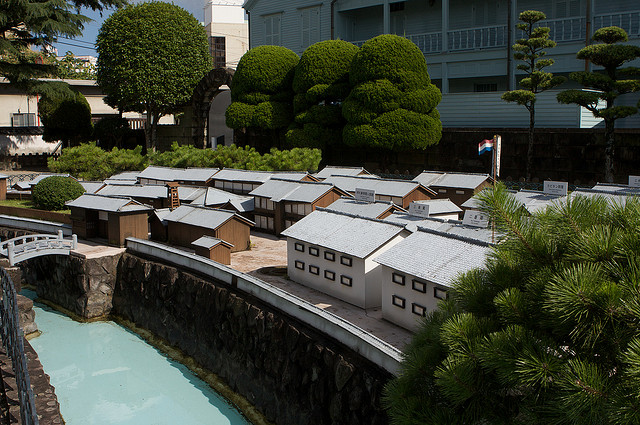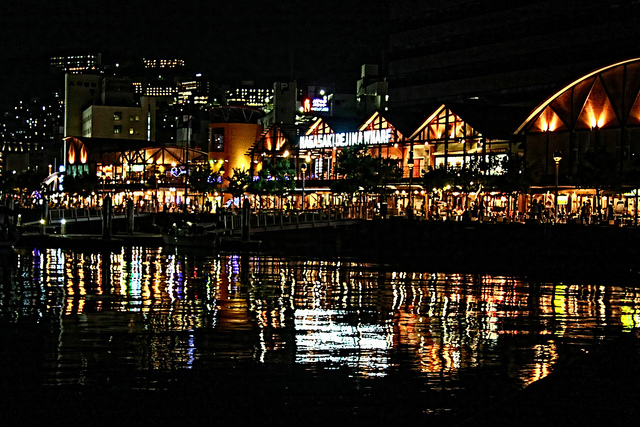Hidden among bustling Nagasaki Harbour lie the remnants of what was once an extraordinary island which served as the one single gateway to a very different Japan.
There is a ghost that resides in the harbour of Nagasaki, and this ghost is distinctly European. Curious to uncover this intangible yet historically important spectre, I resolved to go ghost hunting and see what I could find.
The ghost to which I refer is actually a former island which once stood in the resplendent Nagasaki bay. Artificially created in 1636, its initial purpose was to confine and control the Portuguese who had recently arrived in the region and had been up to their old tricks of conducting missionary activities, the success of which had led to relatively widespread conversion to Christianity, perceived as a threat by the ruling Tokunaga Shogunate.
The rulers ushered in a period of self-imposed isolation known as Sakoku in the wake of a massive rebellion of Christian peasants in Shimabara, situated nearby Nagasaki. The Portugese were unceremoniously booted out, Christianity was forbidden, no foreigners were allowed in and no Japanese were allowed out.
That left the small but awkward matter of what to do with Dejima: the pretty fan-shaped island which had been expensive to construct. It was decided that the altogether less troublesome, more trade-focused, Protestant Dutch would relocate their existing trading posts from the island of Hirado to Dejima.
And so it was that tiny Dejima Island came to become the exclusive point of contact for the West with the Japanese archipelago for over 200 years.
Finding Dejima
Present day Dejima exists as Dejima museum, a compound within Nagasaki harbour easily reached by one of the trams which have merrily trundled around the city since the early 20th century.
En-route I strolled past Dejima wharf, a bay-side section of bars and restaurants with al fresco dining and dog walkers galore. I glanced across the bay and was struck by the staggering beauty of this area of awesome historical importance; the sparkling glittering blue expanse was criss-crossed by ferries coming in and out, and beyond that rose mighty Mt. Inasa, a jade-green emergence said to offer one of Japan’s finest night views. Before drinking my fill of this sumptuous sight, I pottered into Dejima museum, which stood slightly inland from the harbour.
The first thing I encountered was a sense of contrast from the architecture within the compound to the typical modern Japanese buildings outside, which are often functional but rather ugly affairs. Instead here I found tidy streets lined on either side by large buildings in traditional Japanese style from the 17th century, with white walls, dark wooden beams and slanting tiled roofs.
The Chief Factor’s Residence stood as the largest building on the island and had been the stage for meetings between Japanese and Dutch officials. The imposing current building doubled up as an exact recreation from the original blueprints on the outside, and a historical exhibition complete with some fascinating pieces within.
Here I encountered an intriguing model of a Dutch trading ship, which had sailed into the sapphire bay brimming with goods like silk, sugar, cotton and copper from trading posts in Indonesia, Europe and beyond. The corresponding information – helpfully delivered in both English and Japanese – revealed that the ships had at times been limited to just two vessels a year, and each one was rigorously searched and the sails confiscated by the Japanese until they were satisfied that no contraband had been smuggled in.
There was a creeping feeling that Dejima had not been entirely unlike a prison, which was reinforced by the presence of an observation tower, the thick embankment wall encasing the island and the Japanese Official’s Office. It transpired the tradesmen who lived here did so under intense scrutiny, and interaction between the two communities was limited. There were interpreters, merchants and for me most fascinatingly off all, Japanese ‘women of pleasure’ or high class prostitutes.
Here in the small square rooms with bare feet on tatami mat floors, I could almost sense the complicated tangle these spirits had once been in; a microcosm of two peoples, separated by a chasm that was language and culture and law, technically connected only by trade, yet engaging with one another intimately.
Whilst the law of Sakoku dictated that any Japanese caught abandoning its shores or any outsider coming in would be punishable by death, once again the Dutch were the exception. A series of small models in the museum depicted the annual visit to the Shogunate in Edo (present-day Tokyo). A select group from the trading post would be expected to undertake this epic journey to the capital carrying trade goods to honour the ruling Shogun, some of which insisted upon being entertained by traditional Dutch dances.
Looking at these little figures I thought about just how fascinating this journey must have been. Months of isolation and boredom suddenly broken by a trip to the beating heart of a closed land, past soaring mountains and expansive paddy fields tended by curious peasants, who would glance up and stare in blinking wonder at these creatures from another world.
I explored the rest of the buildings, which included a number of warehouses, a seagate where imports and exports had come through and the Head Clerk’s Quarters, which had been a centre of Western learning for select groups of Japanese towards the end of Sakoku.
Back outside I encountered a hulking wooden weighing scale which had been used to weigh out the influx of Dutch trade goods, especially sugar. For me, the scales represented the precarious balance in which this island existed: trading partners but outsiders, isolated but connected, interwoven but separate, free but imprisoned, European but Japanese.
Today’s Dejima is mostly made up of reconstructions. When the Americans eventually prized Japan open like a stubborn clam in 1853, Dejima was effectively made redundant, and many of the original buildings were lost when the land was subsequently reclaimed to build up Nagasaki harbour. The exceptions to this are the former Dejima Protestant Seminary and the former Nagasaki International Club, both striking, wooden, European-style buildings in pastel colours that were erected after the end of Sakoku in an effort to bring the citizens of Nagasaki and foreigners closer together.
Whilst the rest of Dejima had been painstakingly brought back to life, its revival is a work in process. Nagasaki has ambitious plans to restore each of the former buildings and dig canals around its circumference, meaning it will rise again as the island it once was.
Whilst this will undoubtedly create even more of a spectacle, what is already clear from a visit to Dejima museum is just how special and unique this island was. For the most part, Japan is a country with a history almost as homogenous as its present day population, with the majority of its past encounters playing out with neighbouring China and Korea. So to encounter here in Nagasaki a historical point of contact between Europe and Japan stretching back centuries was a rare jewel indeed, one that, if you let it, could set the imagination on fire.
Old and New Entwined
It was curious to note that, when wandering around the Dejima museum, there were very modern articles in among the historical reconstructions. Vending machines blinked on tatami mats, air conditioning units churned out humid air and there was even a cotton candy machine to keep kids entertained. In the kitchen area a dinner table had been exhibited with plastic food, which was zapped by the neon light of a laser pen from the tour guide.
It struck me that in Japan there seems to be less concern for mixing the modern and the historical. In the same way that Osaka Castle stands as both a magnificent historical spectacle and a mostly modern reconstruction – complete with functioning elevator – Dejima was no less important a site for being largely formed of reconstructions. Whilst I felt a slight detachment from the buildings here because they were so new, so pristine and so air conditioned, perhaps I was engaging with it through European eyes. The majority of us would be taken aback if we were to encounter a flashing vending machine dispensing a world of beverages in an ancient castle in England, but that is not a problem here. The machine dispensing cotton candy whirred away and no one batted and eye.
Perhaps it was to do with the Japanese understanding of ‘mono no aware’, which can be described as an understanding of the transience and impermanence of material things, coupled with ‘wabi sabi’, which as an aesthetic that understands beauty as “imperfect, impermanent and incomplete”. These facets of the Japanese Shinto belief system encourage acts like the replacement of the Ise Grand Shrine in Mie Prefecture once every 20 years, not for any practical reason, but simply to honour the importance and aesthetic of the temporary. With this understanding of transience and change so embedded, I considered that Dejima was another example of something lost but brought back to life, and all the more beautiful for it.
Or perhaps it was simpler than that. Perhaps these buildings had been sadly eroded and were being brought back with the same meticulous attention to detail, desire for excellence and fondness for modern comforts that is apparent throughout Japan.
A look into Dejima
My final stop in the museum compound was the large-scale model of Dejima, which gives a tangible insight into how the island had really stood during Sakoku.
Looking down I sensed just how tiny the island was; a fan spreading out in the blue expanse, connected to the mainland by a small bridge and walled on every side.
I began to ponder; what must it have been like, to be directly connected to an entire land which has rejected all but its own? To have been the link, the one link, between one peoples and another? Was every day like waking up beside a sleeping dragon? How must it have been, to be confined but to be free? I looked down into the model and conjured up another boy, about my age, looking out from the confines of this island to the bay extending in front of him, staring up at Mt. Inasa, questioning quite how he got here, quite what he was doing here on this tiny artificial island connected to an isolated land.
Whether this spirit ever existed is anyone’s guess, but my imagined window into his world gave me comfort nonetheless.



